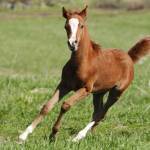Effects of Yeast Culture Supplementation on Growth of Foals

Many breeders are interested in promoting rapid foal growth in an effort to enhance profitability. In the sale ring, premiums are paid for larger foals when all other factors are equal. Of the factors under the horseman’s control, nutrition is a primary target for increased growth. The amount and type of nutrients available to growing horses change dramatically when foals are weaned from their dams, particularly when weaning occurs at an early age.
A study conducted by researchers from the University of Kentucky and a local feed mill was designed to evaluate the effect of weaning on growth rate in Thoroughbred foals. A second objective was to evaluate the effects of yeast culture supplementation on foal growth during the weaning period.
Forty mare/foal units from three farms in central Kentucky were blocked on each farm by age and sex and assigned to a commercial yeast culture or a placebo supplement with a similar appearance. Young horses in the yeast culture and placebo treatment groups were on average 3.8 and 3.7 months of age, respectively, at the onset of the study. Treatments were assigned at least two weeks prior to weaning, and in most cases at least one month prior to weaning. Each mare/foal unit was individually fed at least once a day, and the respective supplement was top-dressed on the grain ration at a rate of 56.8 g/d for mares and 28.4 g/d for foals.
Foals were evaluated prior to the treatment, less than one week prior to weaning, and at 1, 2, 3, 4, 6, and 8 weeks after weaning. Body weight, skeletal measurements, and bone density were recorded, and subjective characteristics such as coat condition and general attitude were evaluated. During the course of this study, three foals were eliminated due to illness or injury.
Average age at weaning was about 4.9 months, but the range was 2.2 to 6.5 months. There were no gender differences in initial pretreatment weights or age at weaning. Across treatments, pre-weaning average daily gain (ADG) was 0.9 kg (2 lb). ADG decreased in the first week post-weaning to 0.3 kg (0.7 lb), but then increased after the first week post-weaning. Growth depression was calculated as a percentage by subtracting post-weaning ADG from pre-weaning ADG and dividing by pre-weaning ADG.
A positive correlation existed between ADG in the two to three weeks prior to weaning and growth depression in the first week post-weaning. Thus, the more rapidly growing foals encountered more weaning depression. However, growth depression during the first week was not related to age at weaning.
Yeast culture supplementation did not affect body weight at any time during the study. Foals supplemented with yeast culture were numerically heavier than the controls; however, these weights were not significantly different during any time period. Differences among farms existed for age at weaning and ADG prior to and immediately following weaning. Variations in management and weaning practices at farms may have contributed to a lack of treatment effect.








